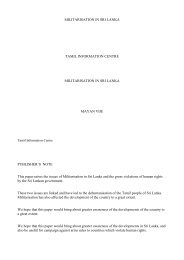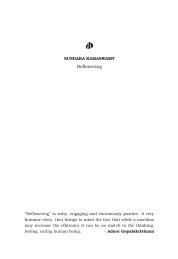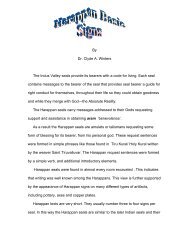Asymmetric Warfare And Low Intensity Maritime Operations
Asymmetric Warfare And Low Intensity Maritime Operations
Asymmetric Warfare And Low Intensity Maritime Operations
- No tags were found...
You also want an ePaper? Increase the reach of your titles
YUMPU automatically turns print PDFs into web optimized ePapers that Google loves.
ORF Occasional Paper<strong>Asymmetric</strong> <strong>Warfare</strong> <strong>And</strong> LIMO: Challenges For Indian NavyWith the discovery of a mini submarine under construction at the Sea Craft Companyyet another small submarine construction was sighted in the waters off Koh HeyIsland, south of Phuket’s Chalong Village. Chalong police found not one but three minisubmarines at a boatyard in Moo , Rawai Village. The boatyard Sea Station Partnershipis owned by Sithichai Wonsrivijit alias Go Chai. Go Chai also runs a diving and snorkelingbusiness at Koh Hey and claims to be an inventor. He invented a helmet for seawalking and had completed building his latest invention.Phuket has also served as an important base for LTTE arms procurement and smuggling.For instance, in February 1996 M V Horizon and M V Comex Jules were destroyedby the Sri Lankan Air Force as the vessels were believed to have onboard a hugeconsignment of arms that originated in Cambodia and were loaded at Phuket.Reportedly, in June 1999, the Moro Islamic Liberation Front (MILF) had made enquirieswith North Korea for a possible sale of a mini submarine. A brochure describinga mini submarine ‘45-foot long with the capacity to carry six persons, including twodivers … designed for special operations with a good tactical range and a low noise level’was found. North Korea has sold more than 10,000 automatic rifles and other arms tothe MILF. In early 2003, Philippines forces had discovered some documentation fromthe MILF camp, which suggested that the MILF was considering purchasing underwaterscooters from Scandinavia.These developments are a clear indicator that both the terrorists and drug cartelsare employing similar tools for their operations. Their focus now appears to be shiftingto underwater capability. This raises two issues: First, availability and cost of underwatervehicles and second, their crew and operations. As regards availability, theseare constructed by using commercially available off-the-shelf technology equipment.According to Dr. Giunio Santi, a naval architect, “a modified underwater barge can supporttwo mini-subs for six months at sea. The barges and all other support equipmentare commercially available and are not considered to be weapons, so that any country- including those restricted in their arms purchasing capabilities - can buy them withoutsupplying company filing purchase notification statements.” The cost of a personal minisubmarine can range from several hundred thousand dollars to tens of millions of dollarsdepending on the size. As far as crew is concerned, it is not difficult to train. All theyneed is good deep-sea diving training and basic engineering knowledge of batteries andunderwater propulsion.Some Working PropositionsHistory tells us that the first-generation warfare was defined by close-order formationsarmed with guns to repel sword-and-bayonet cavalry and infantry, what Napoleonperfected. Second-generation warfare’s winners were those who had the most, or thebest-managed firepower, enabling their forces to win through attrition—an approachmastered by the Prussian army. Third-generation warfare saw second-generation armiesbeing agitated by decentralized attacks that, though brilliant, ultimately failed by virtueof an opponent’s ability to wear the attacker down.Viewed in the context of military history, fourth-generation warfare is highly irregular.“<strong>Asymmetric</strong>” operations—in which a vast mismatch exists between the resourcesand philosophies of the combatants, and in which the emphasis is on bypassing an opposingmilitary force and striking directly at cultural, political, or economic targets—are a defining characteristic of fourth-generation warfare. Its actors rely on asymmetricstrategies and their tools include operations involving terrorism, information warfareand threat of use of weapons of mass destruction.As noted earlier, traditional operational concepts of safeguarding SLOCs, maritimeinterdiction, sea denial, sea control, and defence of maritime infrastructure will dominatethe minds of naval practitioners but it is this type of warfare that Indian navy willface in the coming decades. It will encounter a decentralized enemy in the form of nonstateactors that may be supported by other nations. In order to prepare for and shapeour responses to these threats we would need to predict specific asymmetric threats,build intelligent and imaginative generic strategy for response and develop deterrence.There will be demands on reshaping force structure that is designed to counter asymmetricthreats.Post 9/11, it is believed that the war against terrorism will neither be easy nor short.It is a different kind of conflict than any seen in the past: a struggle against an internationallynetworked enemy dedicated to destruction. This struggle promises to be globalin scope and simultaneous in execution. It will require the full and sustained might ofthe Indian Navy.The India Navy is modernizing and transforming to become a 21st-century navy ofunique capabilities: strategically and operationally responsive, technologically and organizationallyinnovative, joint and networked at every level. Platforms will remain crucialto a 21st-century Navy. Building sufficient platforms is important, but equally importantis building the right ships and aircraft for tomorrow’s fleet--those that possess thecapabilities needed to triumph over emerging threats. While we debate the doctrine of‘reach and reconnaissance’ and build/acquire vessels to provide blue water capabilities,the threats that lurk closer home cannot be discounted. Roughly 60 percent of the shipsin the navy today are designed for distant operations but in future, platforms for coastaloperations would become more important. Precision capabilities will yield greater deterrenceeffectiveness by warning of swift and deadly response to aggression. In short,it will be a fleet that serves as the leading edge of naval defence. Some issues that need21www.orfonline.orgwww.orfonline.org 22
















